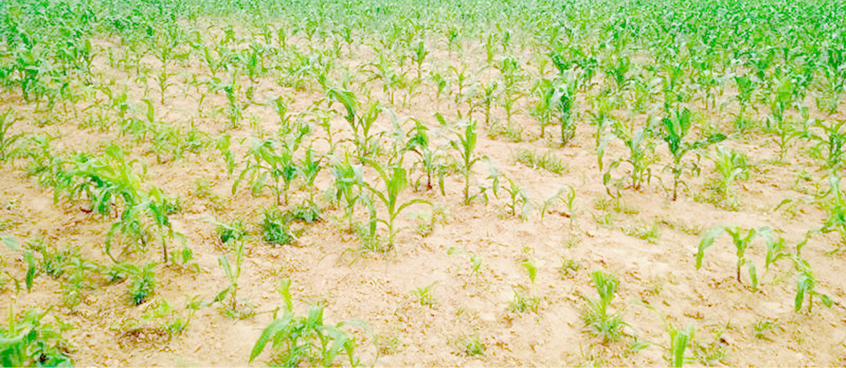Increasing maize yield levels per unit area (productivity) is the major driver as far as achieving food surplus is concerned in Nigeria. Improving maize productivity has immense benefits to the farmer and the nation at large. Basically, what a high productivity level means is that a farmer will be producing more for less in terms of fewer resources (variable costs) and less land area, which has positive implications on enterprise profitability and sustainability. At the farm level, increasing yield per unit area helps reduce the cost of producing a tonne of maize grain.
Good Agronomic Practices (GAPs) ensure that all pre-planting, planting and post-planting operations are followed in simple steps.
PRE-PLANTING OPERATIONS
Start with a well-conditioned soil
Soil pH is an excellent chemical indicator of soil quality (acidity/alkalinity) and its ability to avail nutrients to the crop. A well-conditioned soil has high Fertilizer Use Efficiency (FUE). Liming generally ‘sweetens’ acidic soils by correcting pH to optimum levels. The optimum pH range for maize is 5.5 to 6.5 based on a Calcium Chloride scale.
- India’s worst train crash in decades kills at least 288
- Bayelsa has recorded peace, progress under Diri – Jonathan
- Lime reduces the availability of toxic elements in the soil such as aluminum and manganese.
- Liming improves the soil’s physical structure, resulting in good crop emergence and stand, greater root proliferation, and improved nutrient uptake.
It is therefore important to maintain or condition soils to optimum pH levels (5.5 to 6.5) for maize. This can be achieved by liming following recommendations from soil analysis results.
- Start on a well-prepared seedbed
Thorough land preparation is essential in maize if the crop is to be grown productively and profitably. In fact, successful crop establishment is centered on good land preparation. Conventional land preparation should target the following aspects:
- To loosen the soil and to form a fine tilth-this aids good seed-soil contact and emergence
- To control weeds and start on a weed-free
- seed bed
- To conserve moisture and improve drainage and water movement in the soil.
- Start with the right seed variety
Choosing the right seed variety contributes significantly to increased yields per unit area. A maize bumper harvest begins with choosing the right hybrid seed variety. Farmers should always select hybrids with high yielding ability and good defensive agronomic traits that make them adapt to the current climatic and biotic conditions. Productive farmers target the right variety for their ecologies and use only certified seeds for assurance of performance. SC719, SC649, and SC612 are suitable for areas with medium to high rainfall while series like SC651, SC510, and SC645 are suitable for areas with low rainfall patterns.
- Aim to achieve an optimum population and even stand
A seed rate of 20 to 25 kg is required per ha depending on the seed size while 10 kg is enough to plant 1 acre and 5kg for half an acre.
Establishing an optimum population that allows a hybrid to maximize its yield potential. A good start for the crop offers the best opportunity for higher yields. Farmers are encouraged to always aim to achieve optimum population levels depending on varieties, rainfall, and nutrition-related conditions. Farmers are advised to follow practices that will enhance stand establishment. Adjust seeding depth according to soil conditions and monitor planting depth periodically during the planting operation and adjust for varying soil conditions.
Always make sure the planter is well calibrated and in good working condition.
Inspect and adjust the planter to improve crop stand establishment.
Operate planters at speeds that will optimise seed and fertilizer placement. Uneven emergence affects crop performance because late emerging plants cannot compete with larger, early emerging plants.
In high potential/irrigated environments, a final stand of 50-60 000 plants per hectare can be targeted on most varieties from the 500 series to 700 series, whereas population densities of 37-44 000 plants per hectare are recommended in low rainfall potential areas.
A spacing of 75cm between the ridges and 25cm between plants is recommended with one seed per hole.
A mixture of paraquat and atrazine can be used as a pre-emergence herbicide and sprayed not more than 3 days after planting.
Fertilizer Application, NPK is applied as a basal application at the rate of 6 to 8 bags per ha which translates to a full bottle cap per plant. it can be applied at planting or at 10 to 14 days after planting.
Time of planting
The time of planting has a major effect on the yield of a maize crop as yields decrease with late planting. It is advisable to always plant with the first effective rains. A maize crop that is planted before the start of the main rains has a more vigorous root system and it is therefore beneficial to plant early. Planting early also lengthens the growing season.
FIELD MANAGEMENT OPERATIONS
Weed and pest control
It is important to start with a weed-free field, especially for the first 10-12 weeks of a maize crop cycle as this is the period when more than 60% of the available nutrients are used/required by the crop. So, competition from weeds must be kept to a minimum or to zero. Weeds during this period have a dramatic effect on yields. It is generally advisable to maintain a weed-free maize field throughout the growing season. Generally, failure to control weeds during the first five weeks of the crop cycle leads to a 50% yield reduction. Weeding can be done manually or by application of a selective herbicide.
Source: Seed Co Nigeria




